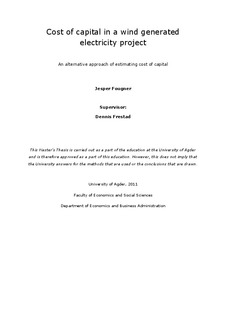| dc.description.abstract | The main purpose of this thesis is to give both a traditional and a new way of estimating the required return on equity and the cost of capital for a wind generated electricity project. The computations are based on the CAPM and the new three factor model by Long Chen, Lu Zhang and Robert Novy-Marx.
The CAPM model’s estimation of cost of equity is 12.5% after tax. Further, the estimations extend to estimating the cost of debt of 5.7%. The project financed by 50% equity and 50% debt yields an after tax WACC of 8.25%. The CAPM model’s estimations is a result of a Norwegian risk free rate, market return on an international diversified portfolio and beta from looking at historical returns from a broad range of relevant comparable companies. The cost of debt and the WACC is a further extension of the CAPM model which is not considered for the three factor model.
The new three factor model consists of a market factor, an investment factor and a return on assets (ROA) factor and their respective beta values. The computation is done by qualitatively arguing the returns found in the article by Chen, Zhang and Novy-Marx from the US stock market to make a fair estimate for the index for the broad international diversified portfolio. The computations of the beta values are argued looking at the general systematic risk aspect for the wind power project for each of the beta values. The computation yields a cost of equity of 20.46% using the multifactor model.
Comparing the cost of equity found by the three factor model of 20.46% and the pre-tax cost of equity of CAPM of 17.4%, there is an apparent difference of results. The reason for this difference will be the increased explanatory power of the new three factor model compared to the CAPM model. According to Chen, Zhang, and Novy-Marx the new factor model captures many of the anomalies that is left to be explained by previous asset pricing model like; financial distress, net stock issues, accruals, earnings surprises and asset growth. The thesis will show that the introduction of the new factors and through these anomalies to an extent are present in our wind power project and are able to capture more of the systemic risk and hence explain the difference of the two models.
In conclusion, the practical implication and validity of the two models are discussed. The new factor model seems to be the best one when it comes to capture more of risk inherent in a wind power project. The CAPM model seems to be the simplest one to use in practice. | en_US |
